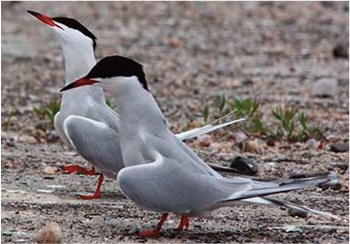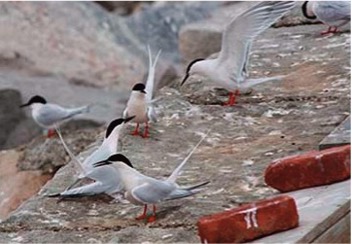
Island © Melinda Billings
Each year, the Linnaean Society sponsors a birdathon to help raise money for Great Gull Island. The island, which was acquired by the American Museum of Natural History in 1949, is home to the world’s largest nesting colony of Common Terns and the largest colony of Roseate Terns in the Western Hemisphere. Located in Long Island Sound next to Plum and Orient Islands, it has remained uninhabited and desolate.
In 1969, ornithologist and naturalist Dr. Helen Hays made a visit to Great Gull Island and realized it was a nesting haven for terns. Since then, she has supervised the repurposing of the island to favor nesting conditions for the birds. Her work has been successful, and the most recent counts of Common Terns show more than 26,000 nesting pairs. Dr. Hays has been recognized for her contributions to bird conservation and has received a service award from the United States Department of the Interior, among other accolades for her work.
This year’s Linnaean Society birdathon raised almost $6,000 to contribute to the island’s maintenance and to help fund the interns who work to keep the island free of invasive plants that could ruin the terns’ nesting sites.

western end of Great Gull Island © Melinda Billings
The Linnaean Society birding teams included Slow Birding Saturday ($4,037); Wandering Warblers ($431); Gnoble Gnatcatchers ($902); and Scarlet Tanagers ($194).
“A birdathon is a fun and challenging day at the office,” said Amy Chaplin, who volunteered on one of the five teams organized by the Linnaean Society.
The Gnoble Gnatcatchers observed 106 species of birds as they birded Sunset Cove Park, Jamaica Bay Wildlife Refuge, and Central Park. Some of the highlights included Blue-winged Teal, Ruby-throated Hummingbird, Clapper Rail, American Oyster- catcher, Willet, Forster’s Tern, Little Blue Heron, Glossy Ibis, Red-headed Woodpecker, Yellow-throated and White-eyed Vireos, Purple Martins, Yellow-headed Blackbird, Rose-breasted Grosbeaks, Scarlet Tanagers and a variety of warblers. These are all species that migrate through the NYC area during the month of May.
— Debbie Becker


